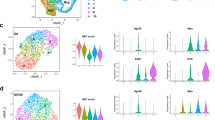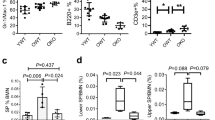Abstract
Cell-intrinsic checkpoints limit the proliferative capacity of primary cells in response to telomere dysfunction. It is not known, however, whether telomere dysfunction contributes to cell-extrinsic alterations that impair stem cell function and organ homeostasis. Here we show that telomere dysfunction provokes defects of the hematopoietic environment that impair B lymphopoiesis but increase myeloid proliferation in aging telomerase knockout (Terc−/−) mice. Moreover, the dysfunctional environment limited the engraftment of transplanted wild-type hematopoietic stem cells (HSCs). Dysfunction of the hematopoietic environment was age dependent and correlated with progressive telomere shortening in bone marrow stromal cells. Telomere dysfunction impaired mesenchymal progenitor cell function, reduced the capacity of bone marrow stromal cells to maintain functional HSCs, and increased the expression of various cytokines, including granulocyte colony-stimulating factor (G-CSF), in the plasma of aging mice. Administration of G-CSF to wild-type mice mimicked some of the defects seen in aging Terc−/− mice, including impairment of B lymphopoiesis and HSC engraftment. Conversely, inhibition of G-CSF improved HSC engraftment in aged Terc−/− mice. Taken together, these results show that telomere dysfunction induces alterations of the environment that can have implications for organismal aging and cell transplantation therapies.
This is a preview of subscription content, access via your institution
Access options
Subscribe to this journal
Receive 12 print issues and online access
$209.00 per year
only $17.42 per issue
Buy this article
- Purchase on Springer Link
- Instant access to full article PDF
Prices may be subject to local taxes which are calculated during checkout




Similar content being viewed by others
References
Min, H., Montecino-Rodriguez, E. & Dorshkind, K. Effects of aging on early B- and T-cell development. Immunol. Rev. 205, 7–17 (2005).
Van Zant, G. & Liang, Y. The role of stem cells in aging. Exp. Hematol. 31, 659–672 (2003).
Nishimura, E.K., Granter, S.R. & Fisher, D.E. Mechanisms of hair graying: incomplete melanocyte stem cell maintenance in the niche. Science 307, 720–724 (2005).
Rando, T.A. Stem cells, aging and the quest for immortality. Nature 441, 1080–1086 (2006).
Conboy, I.M. et al. Rejuvenation of aged progenitor cells by exposure to a young systemic environment. Nature 433, 760–764 (2005).
Lieber, M.R. & Karanjawala, Z.E. Aging, repetitive genomes and DNA damage. Nat. Rev. Mol. Cell Biol. 5, 69–75 (2004).
d'Adda di Fagagna, F. et al. A DNA damage checkpoint response in telomere-initiated senescence. Nature 426, 194–198 (2003).
Vaziri, H. & Benchimol, S. From telomere loss to p53 induction and activation of a DNA-damage pathway at senescence: the telomere loss/DNA damage model of cell aging. Exp. Gerontol. 31, 295–301 (1996).
Djojosubroto, M.W., Choi, Y.S., Lee, H.W. & Rudolph, K.L. Telomeres and telomerase in aging, regeneration and cancer. Mol. Cells 15, 164–175 (2003).
Vulliamy, T. et al. Disease anticipation is associated with progressive telomere shortening in families with dyskeratosis congenita due to mutations in TERC. Nat. Genet. 36, 447–449 (2004).
Rudolph, K.L. et al. Longevity, stress response, and cancer in aging telomerase-deficient mice. Cell 96, 701–712 (1999).
Herrera, E. et al. Disease states associated with telomerase deficiency appear earlier in mice with short telomeres. EMBO J. 18, 2950–2960 (1999).
Allsopp, R.C., Morin, G.B., DePinho, R.A., Harley, C.B. & Weissman, I.L. Telomerase is required to slow telomere shortening and extend replicative lifespan of HSCs during serial transplantation. Blood 102, 517–520 (2003).
Choudhury, A.R. et al. Cdkn1a deletion improves stem cell function and lifespan of mice with dysfunctional telomeres without accelerating cancer formation. Nat. Genet. 39, 99–105 (2007).
Hemann, M.T., Strong, M.A., Hao, L.Y. & Greider, C.W. The shortest telomere, not average telomere length, is critical for cell viability and chromosomal stability. Cell 107, 67–77 (2001).
Hardy, R.R. & Shinton, S.A. Characterization of B lymphopoiesis in mouse bone marrow and spleen. Methods Mol. Biol. 271, 1–24 (2004).
Wilson, A. & Trumpp, A. Bone-marrow haematopoietic-stem-cell niches. Nat. Rev. Immunol. 6, 93–106 (2006).
Adams, G.B. & Scadden, D.T. The hematopoietic stem cell in its place. Nat. Immunol. 7, 333–337 (2006).
Drize, N., Gan, O. & Zander, A. Effect of recombinant human granulocyte colony-stimulating factor treatment of mice on spleen colony-forming unit number and self-renewal capacity. Exp. Hematol. 21, 1289–1293 (1993).
Neben, S., Marcus, K. & Mauch, P. Mobilization of hematopoietic stem and progenitor cell subpopulations from the marrow to the blood of mice following cyclophosphamide and/or granulocyte colony-stimulating factor. Blood 81, 1960–1967 (1993).
Min, H., Montecino-Rodriguez, E. & Dorshkind, K. Effects of aging on the common lymphoid progenitor to pro-B cell transition. J. Immunol. 176, 1007–1012 (2006).
Saba, H.I. Myelodysplastic syndromes in the elderly. Cancer Control 8, 79–102 (2001).
Hornsby, P.J. Telomerization of mammalian cells and transplantation of telomerized cells in immunodeficient mice. Methods Mol. Biol. 240, 147–166 (2004).
Shay, J.W. & Wright, W.E. The use of telomerized cells for tissue engineering. Nat. Biotechnol. 18, 22–23 (2000).
Shelton, D.N., Chang, E., Whittier, P.S., Choi, D. & Funk, W.D. Microarray analysis of replicative senescence. Curr. Biol. 9, 939–945 (1999).
Caruso, C., Lio, D., Cavallone, L. & Franceschi, C. Aging, longevity, inflammation, and cancer. Ann. NY Acad. Sci. 1028, 1–13 (2004).
Davis, T. & Kipling, D. Werner syndrome as an example of inflamm-aging: possible therapeutic opportunities for a progeroid syndrome? Rejuvenation Res. 9, 402–407 (2006).
Zatz, M.M. & Goldstein, A.L. Thymosins, lymphokines, and the immunology of aging. Gerontology 31, 263–277 (1985).
Parrinello, S., Coppe, J.P., Krtolica, A. & Campisi, J. Stromal-epithelial interactions in aging and cancer: senescent fibroblasts alter epithelial cell differentiation. J. Cell Sci. 118, 485–496 (2005).
Rudolph, K.L., Millard, M., Bosenberg, M.W. & DePinho, R.A. Telomere dysfunction and evolution of intestinal carcinoma in mice and humans. Nat. Genet. 28, 155–159 (2001).
Acknowledgements
We thank M. Ballmaier for helping with the sorting, and H. Ema and Z. Li for advice and discussion. This work was supported by the Deutsche Forschungsgemeinschaft (Heisenberg Professorship to K.L.R.: Ru 745/8-1, Ru 745 4-1 and KFO119), the Deutsche Krebshilfe e.V. (10-2236-Ru 2), the Roggenbuck-Stiftung, the Wilhelm-Sander-Stiftung and the Fritz-Thyssen Stiftung.
Author information
Authors and Affiliations
Contributions
Z.J. conducted most of the experiments; H.J., M.J., A.G. and A.T. contributed to the in vitro studies; C.R. and C.K. contributed to the B-cell analysis; Z.J. and K.L.R. designed the study and wrote the manuscript; K.L.R. supervised the project.
Corresponding author
Ethics declarations
Competing interests
The authors declare no competing financial interests.
Supplementary information
Supplementary Fig. 1
Environmental defects in Terc−/− mice impair B-lymphopoiesis. (PDF 104 kb)
Supplementary Fig. 2
Environmental defects in Terc−/− mice accelerate myelopoiesis. (PDF 76 kb)
Supplementary Fig. 3
Environmental defects in Terc−/− mice induce increased mobilization and cell proliferation in hematopoietic stem and progenitor cells. (PDF 45 kb)
Supplementary Table 1
Altered cytokine profile in aged Terc−/− mice. (PDF 19 kb)
Rights and permissions
About this article
Cite this article
Ju, Z., Jiang, H., Jaworski, M. et al. Telomere dysfunction induces environmental alterations limiting hematopoietic stem cell function and engraftment. Nat Med 13, 742–747 (2007). https://doi.org/10.1038/nm1578
Received:
Accepted:
Published:
Issue Date:
DOI: https://doi.org/10.1038/nm1578
This article is cited by
-
A state-of-the-art review on the MicroRNAs roles in hematopoietic stem cell aging and longevity
Cell Communication and Signaling (2023)
-
The roles of bone remodeling in normal hematopoiesis and age-related hematological malignancies
Bone Research (2023)
-
Boosting NAD ameliorates hematopoietic impairment linked to short telomeres in vivo
GeroScience (2023)
-
E3 ubiquitin ligase on the biological properties of hematopoietic stem cell
Journal of Molecular Medicine (2023)
-
Development and validation of a nomogram for prediction of the risk of positive hidden blood loss in the perioperative period of single-level thoracolumbar burst fracture
Journal of Orthopaedic Surgery and Research (2021)



